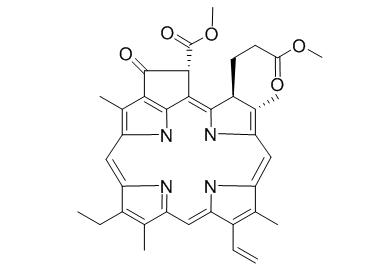Methylpheophorbide A
Methylphophorbide A shows antioxidative and anticarcinogenic activities.
Inquire / Order:
manager@chemfaces.com
Technical Inquiries:
service@chemfaces.com
Tel:
+86-27-84237783
Fax:
+86-27-84254680
Address:
1 Building, No. 83, CheCheng Rd., Wuhan Economic and Technological Development Zone, Wuhan, Hubei 430056, PRC
Providing storage is as stated on the product vial and the vial is kept tightly sealed, the product can be stored for up to
24 months(2-8C).
Wherever possible, you should prepare and use solutions on the same day. However, if you need to make up stock solutions in advance, we recommend that you store the solution as aliquots in tightly sealed vials at -20C. Generally, these will be useable for up to two weeks. Before use, and prior to opening the vial we recommend that you allow your product to equilibrate to room temperature for at least 1 hour.
Need more advice on solubility, usage and handling? Please email to: service@chemfaces.com
The packaging of the product may have turned upside down during transportation, resulting in the natural compounds adhering to the neck or cap of the vial. take the vial out of its packaging and gently shake to let the compounds fall to the bottom of the vial. for liquid products, centrifuge at 200-500 RPM to gather the liquid at the bottom of the vial. try to avoid loss or contamination during handling.
J Food Drug Anal.2023, 31(2):254-277.
J Lipid Res.2024, 65(10):100640.
Processes2020, 8(12),1540.
Neurochem Int.2018, 121:114-124
J Agric Food Chem.2020, 68(51):15164-15175
Am J Chin Med.2015, 30:1-22
J Appl Biol Chem2021, 64(3):245-251.
Heliyon.2024, 10(7):e28755.
Pharmaceuticals (Basel).2024, 17(1):108.
Arch Biochem Biophys.2020, 687:108384.
Related and Featured Products
Photodiagnosis Photodyn Ther. 2017 Mar;17:39-47.
Semi-synthesis and PDT activities of a new amphiphilic chlorin derivative.[Pubmed:
27769913]
An amphiphilic chlorin derivative (CHL-T) was prepared from Methylpheophorbide A (CHL) and 2-Amino-2-(hydroxymethyl)-1,3-propanediol (TRISMA®).
METHODS AND RESULTS:
The new chlorin was compared to other dyes (CHL and Hypericin) in relation to photophysical and photobiological activities in tumor and non-tumor cell lines. Cytotoxicity and cell death target were determined to evaluate the CHL-T efficiency, comparing to the precursor CHL and to the well-known dye hypericin (HY). All of the studied compounds exhibited absorption bands in the therapeutic window and presented a small fluorescence quantum yield compared to the reference dye (rhodamine B). CHL-T was about three times more efficient on singlet oxygen generation than the others photosensitizers. The lipophilicity order of the photosensitizers was CHL>HY>CHL-T. The tumoral HeLa cells presented improved accumulation for CHL and CHL-T compared to HY. The phototoxicity presented by the CHL-T was about ten times higher than by CHL, as demonstrated by the MTT assay. CHL-T showed more cytotoxicity to tumoral cell, comparing to non-tumoral cell in short incubation time. The cell death rises proportionally with increasing PSs concentrations, mainly by necrosis.
CONCLUSIONS:
These findings suggest that CHL-T is a potential new photosensitizer for PDT.
Nat Prod Res. 2016;30(4):474-7.
Antioxidative and anticarcinogenic activities of methylpheophorbide a, isolated from wheat grass (Triticum aestivum Linn.).[Pubmed:
25782530 ]
Methylphophorbide A (MPa) has been isolated from the ethanol extract of the wheat grass plant.
METHODS AND RESULTS:
Its antioxidative efficacy is evaluated by hydroxyl radical scavenging activities and reducing capacity which are significantly up regulated in comparison with aqueous extract of the plant.
The compound shows iron-binding capacity where the Fe(2+) binds with MPa by two types of binding patterns with dissociation constants 157.17 and 27.89. It has antioxidative and cytotoxic effects on HeLa and Hep G2 cells. The cancerous cell survivability decreases with increasing concentration of MPa.
CONCLUSIONS:
These findings have provided evidence for the traditional use of the wheat grass plant in the treatment of cancers, oxidative stress and iron overloaded disorders.



